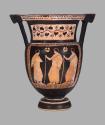Advanced Search
Mixing bowl (column krater)
Style of: The Tarporley Painter
Greek, South Italian
Late Classical Period
about 360–350 B.C.
Place of Manufacture: Italy, Apulia
Medium/Technique
Ceramic, Red Figure
Dimensions
50.6 cm (19 15/16 in.)
Credit Line
Gift of Thomas Gold Appleton
Accession Number76.65
NOT ON VIEW
CollectionsEurope, Ancient Greece and Rome
ClassificationsVessels
Catalogue Raisonné
Vase-Painting in Italy (MFA), no. 025.
DescriptionSide A: Maenad, Dionysos, and satyr.
Side B: Three youths in himations.
Handles repaired and painted over.
This late example of a column krater is typical of its generation in being not taller but more slender and with the neck more flaring. The foot is flared almost to echinus form but retains a reserved groove at top.
ITALIAN VASE PAINTING in ITALY, #25 (76.65)
Column-Krater
The name-vase of the Painter of Boston 76.65
about 360-350 B.C.
A: A maenad wearing a chiton, kekryphalos, and necklace with yellow pendants stands at the left holding a yellow mirror in her left hand. Before her, at the center, stands a nude youth, probably Dionysos, with a white wreath in his hair and a cloak over one arm. He holds a phiale in his left hand and a thyrsos in the right. At the right is a satyr, a white fillet on his head, carrying a situla in his lowered right hand and a tambourine in his raised left. In the lower right corner is a sprig of laurel, and between the satyr and Dionysos grows a small plant. A rosette floats in the field above.
B: A boy, both arms covered by his himation, faces two youths wearing himatia and holding staffs in their right hands. In the field above are filling ornaments in the form of paired jumping weights.
The panels on either side of the neck repeat the earlier practice, seen on cat. no. 9, of a large ivy vine and clusters of berries, a scheme that continues to be standard on apulian column-kraters; note the more naturalistic vine in comparison to that on cat. no. 9. The pictures have lateral frames of degenerate ivy and upper frames of tongues. Both groundlines consist of groups of linked maeanders to left alternating with dotted saltire-squares. There is crude ivy on both sides of the rim, wave-pattern on top of the rim, and black palmettes on the handle-plates.
The Painter of Boston 76.65 was a close associate of the Lycurgus Painter. Most of the few works attributed to him are kraters and pelikai. Although this krater is relatively uncluttered in comparison with more elaborate works, the use of added color and the floral filling ornaments place it in the Ornate-style tradition.
Side B: Three youths in himations.
Handles repaired and painted over.
This late example of a column krater is typical of its generation in being not taller but more slender and with the neck more flaring. The foot is flared almost to echinus form but retains a reserved groove at top.
ITALIAN VASE PAINTING in ITALY, #25 (76.65)
Column-Krater
The name-vase of the Painter of Boston 76.65
about 360-350 B.C.
A: A maenad wearing a chiton, kekryphalos, and necklace with yellow pendants stands at the left holding a yellow mirror in her left hand. Before her, at the center, stands a nude youth, probably Dionysos, with a white wreath in his hair and a cloak over one arm. He holds a phiale in his left hand and a thyrsos in the right. At the right is a satyr, a white fillet on his head, carrying a situla in his lowered right hand and a tambourine in his raised left. In the lower right corner is a sprig of laurel, and between the satyr and Dionysos grows a small plant. A rosette floats in the field above.
B: A boy, both arms covered by his himation, faces two youths wearing himatia and holding staffs in their right hands. In the field above are filling ornaments in the form of paired jumping weights.
The panels on either side of the neck repeat the earlier practice, seen on cat. no. 9, of a large ivy vine and clusters of berries, a scheme that continues to be standard on apulian column-kraters; note the more naturalistic vine in comparison to that on cat. no. 9. The pictures have lateral frames of degenerate ivy and upper frames of tongues. Both groundlines consist of groups of linked maeanders to left alternating with dotted saltire-squares. There is crude ivy on both sides of the rim, wave-pattern on top of the rim, and black palmettes on the handle-plates.
The Painter of Boston 76.65 was a close associate of the Lycurgus Painter. Most of the few works attributed to him are kraters and pelikai. Although this krater is relatively uncluttered in comparison with more elaborate works, the use of added color and the floral filling ornaments place it in the Ornate-style tradition.
ProvenanceBy 1869: Thomas Gold Appleton Collection (according to Robinson, Catalogue, no. 489: purchased by him of Alessandro Castellani, 1869; from Ruvo); gift of Thomas Gold Appleton to MFA, 1876;



